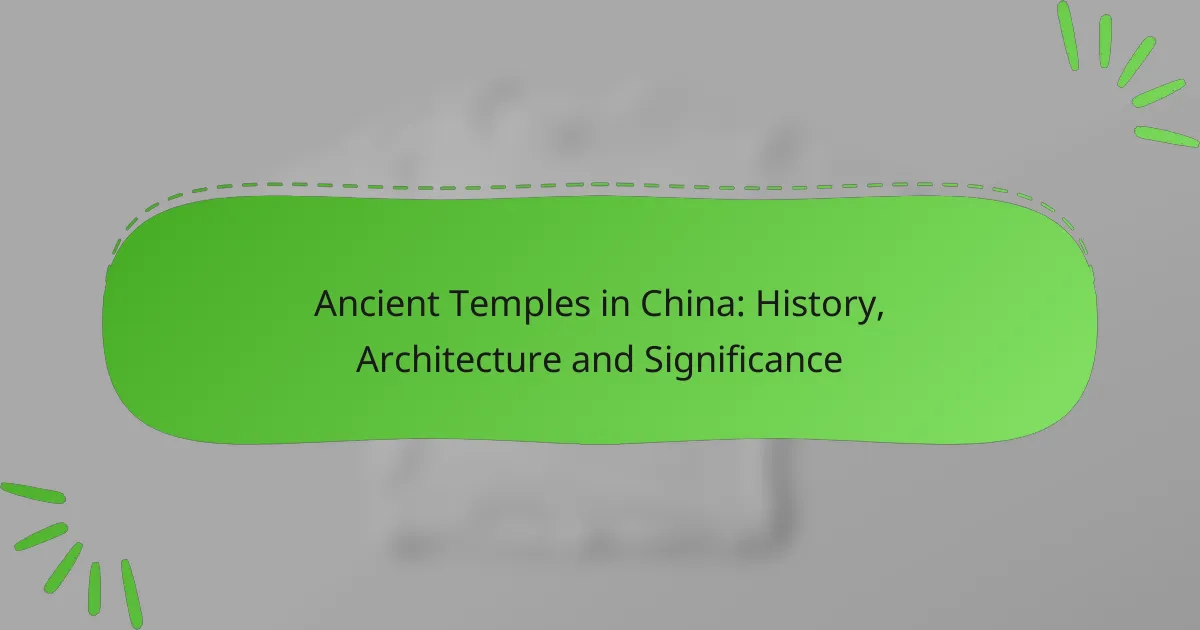Ancient temples in China are remarkable sites that embody the country’s rich history and cultural heritage. These structures, such as the Temple of Heaven and Shaolin Temple, showcase unique architectural styles and reflect the spiritual beliefs that have evolved over centuries. They serve as vital centers for religious practices and offer insight into the societal values and political dynamics of their time.

What are the most significant ancient temples in China?
China is home to numerous ancient temples, each with unique historical and cultural significance. Among the most notable are the Temple of Heaven, Shaolin Temple, Linggu Temple, Yonghe Temple, and Confucius Temple, each representing different aspects of Chinese spirituality and architecture.
Temple of Heaven
The Temple of Heaven, located in Beijing, is a masterpiece of Ming architecture and a UNESCO World Heritage Site. Built in the early 15th century, it served as a place for emperors to perform rituals to ensure good harvests.
This temple complex features a circular Hall of Prayer for Good Harvests, symbolizing the connection between heaven and earth. Visitors can appreciate its intricate design and the surrounding park, which is popular for tai chi and other activities.
Shaolin Temple
Shaolin Temple, situated in Henan Province, is renowned for its association with Chinese martial arts, particularly Shaolin Kung Fu. Founded in the 5th century, it is considered the birthplace of this martial discipline.
The temple complex includes several halls and pagodas, showcasing ancient architecture and Buddhist relics. Visitors can attend martial arts demonstrations and learn about the temple’s rich history of meditation and combat training.
Linggu Temple
Linggu Temple, located in Nanjing, is known for its beautiful surroundings and historical significance. Established during the Liang Dynasty, it features a unique wooden pagoda and offers a serene atmosphere for reflection.
The temple complex is surrounded by lush forests and is a popular destination for both tourists and locals seeking tranquility. Its architecture reflects traditional Chinese styles, making it a great spot for photography and exploration.
Yonghe Temple
Yonghe Temple, also known as the Lama Temple, is one of the largest and most important Tibetan Buddhist monasteries in the world, located in Beijing. Built in the 17th century, it showcases a blend of Han and Tibetan architectural styles.
The temple is famous for its impressive statues, including a massive Maitreya Buddha carved from a single sandalwood tree. Visitors can explore the various halls and experience the vibrant atmosphere created by the monks and worshippers.
Confucius Temple
The Confucius Temple in Qufu, Shandong Province, is dedicated to the memory of Confucius, the great philosopher and educator. This temple complex is one of the largest in China and reflects the importance of Confucianism in Chinese culture.
Visitors can explore the grand halls and pavilions that honor Confucius and his teachings. The temple is also home to a large cemetery and a school where Confucian scholars studied, making it a significant site for understanding Chinese philosophy and education.

What is the historical significance of ancient temples in China?
Ancient temples in China hold profound historical significance as centers of spirituality, culture, and governance. They reflect the evolution of religious practices, societal values, and political power throughout Chinese history.
Religious practices and rituals
Ancient temples served as vital locations for religious practices and rituals, primarily associated with Buddhism, Taoism, and Confucianism. These sites facilitated ceremonies, offerings, and festivals that reinforced community bonds and spiritual beliefs.
For instance, the Temple of Heaven in Beijing was where emperors performed annual rites to ensure good harvests, showcasing the intertwining of religion and governance. Such rituals were essential in maintaining harmony between heaven and earth, reflecting the cultural significance of these temples.
Cultural heritage and identity
Temples are crucial to China’s cultural heritage, embodying artistic and architectural achievements. They often feature intricate carvings, paintings, and designs that represent historical narratives and local traditions.
For example, the Longmen Grottoes, with thousands of Buddhist statues, illustrate the artistic styles of various dynasties. These sites contribute to a shared cultural identity, fostering pride and continuity among communities.
Political influence and power
Ancient temples were not only religious centers but also symbols of political authority. Rulers often constructed grand temples to legitimize their power and demonstrate their commitment to the divine order.
The Forbidden City, while primarily a palace, includes numerous temples that served as sites for state rituals, reinforcing the emperor’s role as a mediator between heaven and the people. This connection between temples and political power highlights their importance in shaping China’s historical landscape.

How did ancient Chinese architecture influence temple design?
Ancient Chinese architecture significantly shaped temple design through its emphasis on harmony, balance, and spiritual alignment. Key architectural principles such as symmetry and feng shui were integral in creating structures that not only served religious purposes but also resonated with the natural environment.
Use of symmetry and feng shui
Symmetry is a fundamental aspect of ancient Chinese architecture, reflecting the belief in balance and order. In temple design, symmetrical layouts are common, with structures typically arranged around a central axis, enhancing the spiritual experience for visitors.
Feng shui, the ancient practice of arranging space to promote harmony, played a crucial role in temple placement and orientation. Temples were often situated in locations that aligned with natural features, such as mountains and rivers, to harness positive energy and create a serene atmosphere.
Materials and construction techniques
Ancient Chinese temples were primarily constructed using wood, stone, and brick, with wood being the most prevalent due to its availability and flexibility. Traditional joinery techniques, such as mortise and tenon, allowed for sturdy structures without the use of nails, which contributed to the longevity of these buildings.
In addition to wood, stone was often used for foundations and decorative elements, providing stability and aesthetic appeal. The use of glazed tiles for roofs not only added color but also served practical purposes, such as waterproofing and insulation.
Symbolism in architectural elements
Symbolism is deeply embedded in the architectural elements of ancient Chinese temples. Roof designs often feature upward-curving eaves, which symbolize the aspiration towards the heavens and the divine. Additionally, decorative motifs, such as dragons and phoenixes, represent power, protection, and harmony.
Columns and beams are frequently adorned with intricate carvings that convey stories or moral lessons, reinforcing the spiritual significance of the temple. These elements serve not only as structural supports but also as visual narratives that connect worshippers with their cultural heritage.

What are the key architectural features of Chinese temples?
The key architectural features of Chinese temples include their unique structures, roof designs, and intricate decorative elements. These characteristics reflect the cultural and spiritual significance of the temples, showcasing traditional craftsmanship and aesthetic principles.
Pagoda structures
Pagodas are iconic elements of Chinese temple architecture, often serving as reliquaries or places of worship. Typically multi-storied, these structures feature a series of stacked, tiered roofs that taper as they rise, symbolizing the connection between heaven and earth. The height and number of stories can vary, with some pagodas reaching several dozen meters.
Common materials for pagodas include wood and brick, with wooden pagodas being particularly notable for their intricate joinery and lack of nails. The design often incorporates a square or octagonal base, enhancing stability and aesthetic appeal.
Roof styles and eaves
The roofs of Chinese temples are characterized by their sweeping curves and elaborate eaves, which extend outward to create a dramatic silhouette. This style not only serves aesthetic purposes but also helps to divert rainwater away from the building. Roofs are typically adorned with colorful tiles, often glazed, which add vibrancy to the structure.
Different regions in China may feature distinct roof styles, such as the upturned eaves of southern temples versus the flatter roofs found in northern designs. The choice of roof style can also reflect the temple’s function and the local climate.
Decorative carvings and motifs
Decorative carvings and motifs are essential to the visual identity of Chinese temples, often depicting religious symbols, mythical creatures, and natural elements. These intricate designs are typically found on wooden beams, door frames, and stone pillars, showcasing the skill of artisans. Common motifs include dragons, phoenixes, and lotus flowers, each carrying specific cultural meanings.
In addition to enhancing beauty, these carvings often serve to convey moral lessons or spiritual beliefs, making them integral to the temple’s purpose. The level of detail and craftsmanship can vary significantly, with some temples featuring highly elaborate decorations while others maintain a more minimalist approach.

How do ancient temples in China compare to those in other cultures?
Ancient temples in China exhibit unique architectural and cultural characteristics that set them apart from those in other cultures, such as India and Greece. While they often share common themes of spirituality and community, their design, materials, and purposes can differ significantly.
Similarities with Indian temples
Both ancient Chinese and Indian temples serve as vital centers for religious and cultural activities, reflecting the spiritual beliefs of their respective societies. They often feature intricate carvings and sculptures that depict deities and mythological stories, showcasing the artistic skills of their builders.
Architecturally, both temple styles emphasize symmetry and alignment with cosmic principles. For instance, Chinese temples often incorporate wooden structures with sweeping roofs, while Indian temples may use stone with towering shikharas. Despite these differences, both types of temples aim to create a harmonious environment conducive to worship.
Visitors to these temples can experience rituals and festivals that highlight their cultural significance. In both China and India, these events often attract large crowds, demonstrating the temples’ roles as community hubs. Understanding these similarities can enhance appreciation for the rich heritage found in both cultures.










